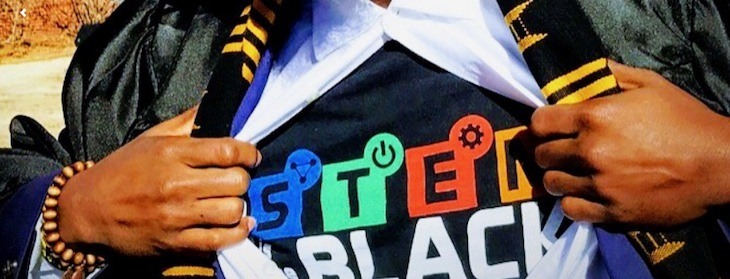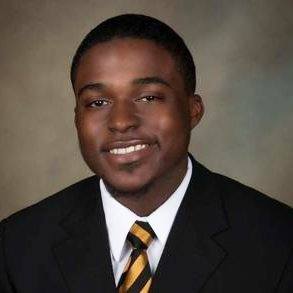UA engineering grad says support for diversity cannot be passive
by February 5, 2018 2:53 pm 811 views

University of Arkansas College of Engineering alumnus Jakym Battle returned to the university Jan. 29 in order to give a speech on diversity and inclusion in STEM (science, technology, engineering and math) fields at the Faulkner Performing Arts Center.
Battle received a dual degree in chemistry and chemical engineering, from Fort Valley State University in Georgia and the UA, respectively, in 2015. Now, he is a technical sales consultant at DuPont in Detroit and founder of an organization to encourage African-American students to focus on STEM.
STEM Is the New Black, founded in 2017, is a grassroots project aimed at “reshaping the culture around STEM,” Battle said. Diversity and inclusion means potential students of all backgrounds feel welcome, he said.
“In terms of bringing students to the campus, you can show them all the amazing facilities, everything the university has to offer, but you hit a wall when a student says, ‘I appreciate the opportunity, but I don’t think I can find myself at home in Fayetteville or at the University of Arkansas,’” he said.
Battle said individuals many times say they are not against diversity but, at the same time, they don’t want to be involved in efforts to promote diversity and inclusion.
“It doesn’t work when you have one professor, or one department head, or even one dean that believes in diversity. That won’t necessarily change the culture,” Battle said. “We must understand this is an active process. … It requires an active decision from each and every individual.
“A lot of times, we don’t recognize that indecision is a decision within itself,” he said, adding if individuals take a passive stance, they forfeit their voices in the conversation, leaving a blank slate that can be filled by other voices and as a result misrepresent the college.
He pointed to an instance where a person wearing an Arkansas Engineering shirt was shown in photos from a White supremacist rally in Charlottesville, Va., that ended in tragedy with the death of a counter-protestor this past August. The person in the photo was initially mistaken for a university professor, and, as of February, the photo showed up in the top results for a Google image search of “Arkansas engineering.”
“As an alum, this is not what I would want for my alma mater to look like,” Battle said, referring to the image.
He expressed concern that potential students with remote interest in the school might see the photo as a depiction of the culture within the engineering program. At the time of the incident, the UA Chancellor Joseph Steinmetz denounced the rally on Twitter, asserting it did not reflect the university’s values.

Shortly after the photo emerged, a university professor was misidentified as the protestor, but Nick DeMoss, director of communications for the college, said the school worked to correct the record.
DeMoss said in a statement: “We were certainly aware of the potential for harm to the college and the faculty member who was misidentified as being involved. This case of mistaken identity became a national example of how not everything you see on social media has been fact-checked. We worked to get out the facts – that no one from the university was involved. It took a few days but the truth emerged, with local and national media helping to set the record straight. In the end, we’re hopeful that we were successful in creating awareness that the person in the photo does not reflect us or our values.”
STRIVING FOR DIVERSITY
Increasing student quality and diversity is one of the key objectives listed in the college’s strategic plan, as outlined in the UA College of Engineering’s 2017 Fact Book, published in January. (Link here for a PDF of the book.)
The school’s Engineering Career Awareness Program (ECAP) recruits and offers scholarships to underrepresented populations within the engineering field, including first-generation college students, women and ethnic minorities. As of 2017, 55% of the scholarship recipients were female, half were Hispanic, and the rest of the group was 37% African-American, close to 7% Native American, close to 5% white and close to 2% Pacific Islander.
Ethnic diversity in graduate and undergraduate programs, in addition to the faculty, was at a five-year low this past fall. The minority population in graduate programs and the faculty fell below 20%, and the undergraduate program had a minority population of about 22%. The figures do not include distance or international students.
Still the minority share of the engineering school population shows marked increase between 2006 and 2016. Minority enrollment increased 472% during that time, versus an average of 207% among the college’s peers, said Bryan Hill, assistant dean for student recruitment and diversity, honors and international programs, citing statistics from the American Society for Engineering Education. Hill pointed to enrollment growth in the college across the board.
“Enrollment growth has been strong in the College of Engineering, particularly among minority and female students,” he said in a statement. “In comparing the college’s enrollment growth to its peer institutions, the UA’s engineering program has outpaced its peers.”
According to ASEE, the UA’s engineering enrollment increased 122% between 2006 and 2016, compared to an average 103% increase among its peers. Female enrollment has increased 258% during that time, versus 162% among the other schools.
RETENTION IS KEY
Enrollment in the College of Engineering was at an all-time high this past fall semester, at 3,393 students, according to the school. Undergrad enrollment has more than doubled since 2007, and it increased 2.5% from 2016. Females comprise close to a quarter (24%) of the freshman class of 802, representing an all-time high, according to the school.
Degree production has also increased, Hill said. During the same time period between 2006 and 2016, the UA’s bachelor engineering degrees have increased 146%, with female degree-earners growing by 213% and minority degree earners by 283%. Peer institutions increased bachelor production of 82%, 84% for women and 170% for minorities.
Battle said among the female demographic there is an “alarmingly” low rate of individuals wanting to study STEM in college.
“We know there is a certain group where we need to encourage and push the idea of STEM a little more.”
From a race perspective, retention is where there is a drop-off for African-Americans. The retention rate is not proportional among races, with blacks and Hispanics more likely to not finish. In terms of the approach for improving female and minority participation in STEM, Battle said there is a need to adjust based on the situation.
“We can sit here and analyze data until we’re blue in the face, but at what point do you analyze the fact that the issue you’re dealing with from a gender standpoint might not be the exact issue from a race standpoint?” Battle said. “We need to be mindful of the fact that there should be a multidimensional approach.”
